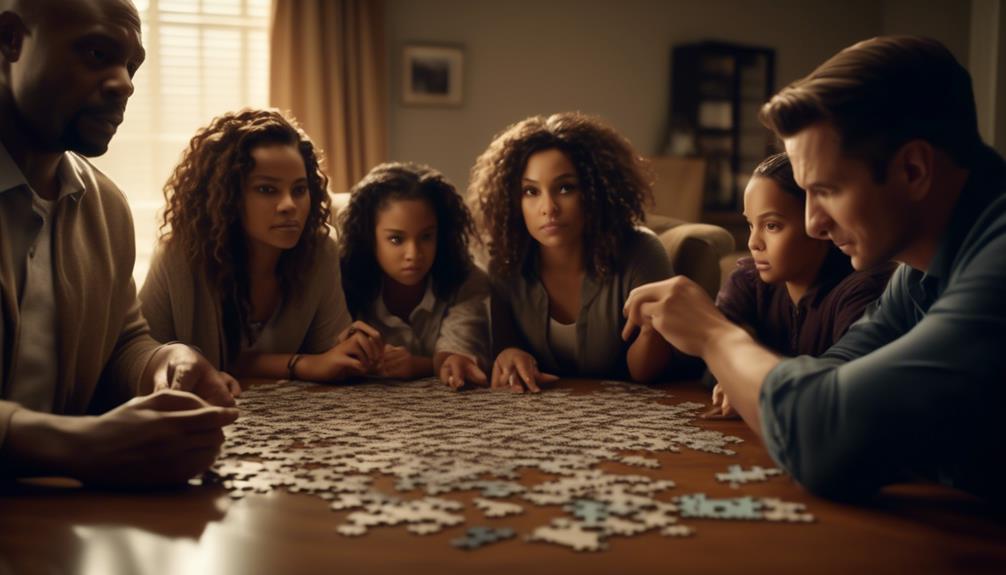What Is Collaborative Problem-Solving in Family Conflicts?

Collaborative problem-solving in family conflicts is a method that empowers families to address conflicts. It does this by fostering understanding, cooperation, and growth. This method ultimately transforms conflict into an opportunity for deeper connection and resolution.
Definition of Collaborative Problem-Solving
Collaborative problem-solving, a dynamic and transformative approach, empowers individuals to work together in finding mutually beneficial solutions to family conflicts. When it comes to resolving issues within the family, collaboration offers numerous benefits that can lead to stronger relationships and a more harmonious environment.
By engaging in collaborative problem-solving, family members not only address the immediate conflict, but also build trust, improve communication, and develop problem-solving skills that can be applied to future situations.
Implementing collaborative problem-solving requires a few essential steps.
First, it's important to create an atmosphere of openness and trust, where everyone feels comfortable expressing their thoughts and concerns. This can be achieved by actively listening to each other, acknowledging different perspectives, and refraining from judgment.
Next, all parties involved should identify the underlying interests and needs driving the conflict, rather than focusing solely on positions or demands. By understanding the underlying motivations, it becomes easier to find creative solutions that meet everyone's needs.
Lastly, collaborative problem-solving involves brainstorming and evaluating potential solutions together, aiming for win-win outcomes that satisfy everyone involved.
Key Principles of Collaborative Problem-Solving
To effectively engage in collaborative problem-solving, it's crucial to understand and apply key principles that promote open communication and foster productive resolutions. By following these principles and implementing the necessary steps, you can create an environment conducive to resolving family conflicts and building stronger relationships.
Here are some key principles to keep in mind when engaging in collaborative problem-solving:
- Respect and empathy: Treat each family member with respect and empathy, acknowledging their feelings and perspectives. This will create a safe space for open and honest communication.
- Active listening: Practice active listening by attentively hearing and understanding each person's point of view. This will help you gain insight into their needs and concerns.
To implement these principles effectively, follow these steps:
- Define the problem: Clearly identify the issue at hand and ensure everyone involved understands it. This will help focus the discussion and prevent misunderstandings.
- Brainstorm solutions: Encourage creative thinking and generate multiple solutions. Consider the needs and interests of all family members involved.
Benefits of Collaborative Problem-Solving in Family Conflicts
When engaging in collaborative problem-solving in family conflicts, you can unlock a multitude of benefits that contribute to harmonious relationships and effective resolutions. Two key elements that play a crucial role in this process are empathy and active listening.
Empathy is the ability to understand and share the feelings of others. In collaborative problem-solving, empathy allows you to put yourself in the shoes of your family members, gaining insight into their perspectives and emotions. This understanding fosters compassion and helps create an environment of trust and mutual support. By acknowledging and validating each other's feelings, you can work together towards finding solutions that address everyone's needs.
Active listening is another essential component of collaborative problem-solving. It involves fully focusing on and comprehending what the other person is saying, without interrupting or judgment. When you actively listen to your family members, you demonstrate respect and value their input. This open and attentive communication encourages honest dialogue and enables a deeper understanding of the issues at hand.
To illustrate the benefits of collaborative problem-solving in family conflicts, let's take a look at the following table:
| Benefits of Collaborative Problem-Solving in Family Conflicts | |
|---|---|
| Improved communication | Enhanced understanding |
| Strengthened relationships | Effective conflict resolution |
| Increased empathy | Greater harmony |
Steps to Implement Collaborative Problem-Solving
Now that you understand the benefits of collaborative problem-solving in family conflicts, it's time to delve into the practical steps you can take to implement this approach in your own life.
The first point to consider is the importance of collaboration itself, as it encourages everyone involved to contribute their ideas and perspectives.
Additionally, effective communication strategies play a crucial role in maintaining open and respectful dialogue, allowing for a deeper understanding of each other's needs and concerns.
Lastly, conflict resolution techniques will help guide the process towards finding mutually agreeable solutions.
Benefits of Collaboration
Implementing collaborative problem-solving in family conflicts can bring about numerous benefits for all parties involved. By working together to find solutions, you can improve relationships and foster creativity within your family dynamic. Here are some key advantages of collaboration:
- Improved relationships: Collaborative problem-solving allows family members to communicate openly, listen to each other's perspectives, and work towards a shared goal. This process promotes understanding, empathy, and trust, strengthening the bonds between family members.
- Fostering creativity: When different family members come together to solve a problem, they bring their unique perspectives, experiences, and ideas to the table. This diversity of thought stimulates creativity and innovation, leading to more effective and sustainable solutions.
Effective Communication Strategies
To effectively implement collaborative problem-solving in family conflicts, it is crucial to employ specific communication strategies that promote understanding, active listening, and constructive dialogue. Active listening involves fully engaging with the speaker, seeking to understand their perspective without interrupting or judging. It requires giving your full attention, maintaining eye contact, and using verbal and non-verbal cues to show interest and empathy. Assertive communication, on the other hand, involves expressing your needs, concerns, and boundaries in a respectful and direct manner. It allows you to clearly communicate your thoughts and feelings while also being open to hearing and understanding the perspectives of others. By incorporating active listening and assertive communication into your family discussions, you can foster a more collaborative and harmonious environment where conflicts can be resolved effectively.
| Communication Strategy | Description |
|---|---|
| Active Listening | Fully engaging with the speaker, seeking to understand their perspective without interruption or judgment. |
| Assertive Communication | Expressing needs, concerns, and boundaries in a respectful and direct manner, while also being open to hearing others' perspectives. |
Conflict Resolution Techniques
By building upon effective communication strategies, you can now explore the essential conflict resolution techniques that will enable you to implement collaborative problem-solving in family conflicts. When it comes to resolving conflicts within your family, it's crucial to approach the situation with empathy and a desire to find a mutually beneficial solution.
Here are some conflict resolution methods and family mediation techniques that you can employ:
- Active Listening: Practice active listening by giving your full attention to the other person, acknowledging their feelings, and paraphrasing their concerns to show understanding.
- Win-Win Negotiation: Aim for a solution that satisfies the needs and interests of all parties involved, focusing on compromise and finding common ground.
- Brainstorming: Encourage open and creative thinking to generate multiple possible solutions.
- Problem-Solving: Collaboratively analyze the pros and cons of each solution and choose the one that best addresses the underlying issues.
Effective Communication Techniques for Collaborative Problem-Solving
Discovering effective communication techniques is essential for successful collaborative problem-solving in family conflicts.
When it comes to resolving conflicts within your family, active listening is a vital skill that can help foster understanding and empathy. By actively listening to each other, you demonstrate that you value and respect the other person's perspective. This means giving your undivided attention, maintaining eye contact, and being fully present in the conversation.
Another important communication technique is problem identification. Before you can find a solution, it's crucial to identify and define the problem at hand. Take the time to explore the underlying issues and emotions that may be contributing to the conflict. This will help you gain a deeper understanding of the situation and allow you to address the root cause rather than just the surface-level disagreements.
In addition to active listening and problem identification, effective communication techniques for collaborative problem-solving include using 'I' statements to express your feelings and needs, maintaining a calm and respectful tone, and seeking clarification when needed.
Establishing Trust and Mutual Respect in Collaborative Problem-Solving
Establishing trust and mutual respect is the foundation for effective collaborative problem-solving in family conflicts. Without these essential elements, it becomes challenging to have open and honest communication, which is crucial in resolving conflicts and finding mutually beneficial solutions.
To establish trust and mutual respect in collaborative problem-solving, consider the following:
- Active Listening: Actively listen to each family member's perspective without interrupting or passing judgment. This shows that you value their opinions and encourages them to express themselves openly.
- Empathy and Understanding: Put yourself in the shoes of others and try to understand their feelings and experiences. This fosters compassion and helps build a sense of trust, as family members feel heard and validated.
- Effective Communication: Clearly communicate your thoughts and feelings, using 'I' statements to avoid blaming or accusing others. This promotes a respectful and non-confrontational atmosphere, encouraging others to do the same.
- Collaboration: Encourage collaboration by involving all family members in the problem-solving process. This demonstrates that everyone's opinions and contributions are valued, fostering a sense of mutual respect.
Overcoming Challenges in Collaborative Problem-Solving
Navigating through collaborative problem-solving can be a complex journey filled with various challenges that require patience, understanding, and effective strategies.
Overcoming obstacles is a crucial aspect of promoting teamwork and achieving successful outcomes in family conflicts. One of the challenges you may encounter is communication breakdowns. Misunderstandings can arise when individuals fail to actively listen to each other or express their thoughts and feelings in a clear and respectful manner. To overcome this obstacle, it's important to foster open and honest dialogue, encourage active listening, and validate each other's perspectives.
Another challenge is managing emotions. Family conflicts can evoke strong emotions such as anger, frustration, and sadness. It's vital to recognize and regulate these emotions to prevent them from derailing the problem-solving process. Practicing self-awareness, empathy, and emotional intelligence can help in overcoming this challenge.
Additionally, addressing power imbalances within the family dynamic can be another hurdle. It's important to create a safe and inclusive space where all family members feel empowered to contribute and participate equally. By promoting fairness, respect, and collaboration, you can overcome this obstacle and foster a sense of teamwork.
Collaborative problem-solving in family conflicts requires perseverance, flexibility, and a commitment to finding common ground. By overcoming these challenges, you can create a harmonious and supportive environment where family members can work together to resolve conflicts and strengthen their relationships.
Examples of Successful Collaborative Problem-Solving in Family Conflicts
Successful collaborative problem-solving in family conflicts often involves finding creative solutions that meet the needs and interests of all family members involved. Through effective strategies and open communication, families can achieve successful outcomes and strengthen their relationships.
Here are some examples of how collaborative problem-solving can lead to positive resolutions:
- Active listening and empathy: When family members take the time to truly listen to each other's perspectives and show empathy, it creates a safe space for meaningful dialogue. This allows everyone to better understand each other's needs and concerns, paving the way for mutually beneficial solutions.
- Brainstorming and compromise: Collaborative problem-solving encourages brainstorming sessions where family members can freely share ideas and thoughts. By exploring different options and considering everyone's input, families can find compromises that satisfy everyone's interests.
- Mediation or family therapy: In cases where conflicts become too difficult to resolve independently, seeking help from a neutral third party, such as a mediator or family therapist, can be highly effective. These professionals can facilitate communication, provide guidance, and help families reach resolutions that address the underlying issues.
Frequently Asked Questions
How Does Collaborative Problem-Solving Differ From Other Conflict Resolution Approaches?
You know when you're in a conflict with your family and it feels like you're going head-to-head? Well, collaborative problem-solving is like the superhero version of conflict resolution. It's all about working together, finding common ground, and reaching win-win solutions. It's a game-changer.
Can Collaborative Problem-Solving Be Applied to Conflicts Outside of Family Settings?
You'll be glad to know that collaborative problem-solving can indeed be applied to conflicts outside of family settings. It has proven effective in workplace conflicts and community disputes, fostering understanding and finding mutually beneficial solutions.
Are There Any Limitations or Potential Drawbacks to Using Collaborative Problem-Solving in Family Conflicts?
When it comes to collaborative problem-solving in family conflicts, there may be some limitations and potential drawbacks to consider. It's important to be aware of these factors in order to navigate the process effectively and ensure positive outcomes for all parties involved.
How Long Does It Typically Take to See Positive Results From Implementing Collaborative Problem-Solving in Family Conflicts?
Typically, you can start seeing positive results from implementing collaborative problem-solving in family conflicts within a few weeks. Its effectiveness lies in the timeframe it takes to address and resolve issues together, fostering a stronger and more harmonious family unit.
What Role Does Empathy Play in Collaborative Problem-Solving and How Can It Be Effectively Practiced in Family Conflicts?
In collaborative problem-solving, empathy plays a crucial role. It helps you understand others' perspectives, fostering better communication and resolution. To practice empathy effectively in family conflicts, listen actively, validate feelings, and show understanding and support.











